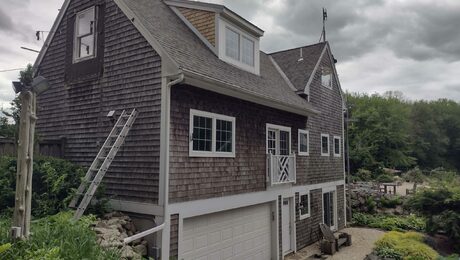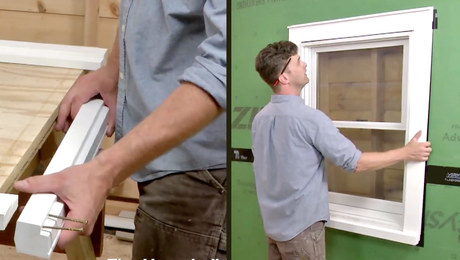*
I recently bought a single story block house. It’s 35 feet by 35 feet and built on a slab. I want to take off the roof and build a half story on top. I’m worried whether or not the foundation will support the added weight. The way I figure it I’m not adding that much more weight. But the weight I am adding is going to be living space. All of the advise I’ve gotten so far has been “dig down and see what kind of foundation you’ve got. if it’s pretty thick you should be ok” I don’t like the word “should”. The house was built in 54. Here’s the question. How do I determine whether or not the foundation will support the added weight? Is there some core test for concrete that is 47 years old. Is there some formula for thickness of the slab will support X weight. AJ what are your thoughts? Matt Galvin, is there some link you can supply from your wealth of archival information? I can also entertain other ideas like expanding from the sides with a new footer. Any ideas? FTDS GREG
Discussion Forum
Discussion Forum
Up Next
Video Shorts
Featured Story

Listeners write in about ventilation and radon control and ask questions about tightening basement garages, ventilation solutions, and safer paint stripper.
Featured Video
How to Install Exterior Window TrimHighlights
"I have learned so much thanks to the searchable articles on the FHB website. I can confidently say that I expect to be a life-long subscriber." - M.K.
Fine Homebuilding Magazine
- Home Group
- Antique Trader
- Arts & Crafts Homes
- Bank Note Reporter
- Cabin Life
- Cuisine at Home
- Fine Gardening
- Fine Woodworking
- Green Building Advisor
- Garden Gate
- Horticulture
- Keep Craft Alive
- Log Home Living
- Military Trader/Vehicles
- Numismatic News
- Numismaster
- Old Cars Weekly
- Old House Journal
- Period Homes
- Popular Woodworking
- Script
- ShopNotes
- Sports Collectors Digest
- Threads
- Timber Home Living
- Traditional Building
- Woodsmith
- World Coin News
- Writer's Digest


















Replies
*
There are lots of factors to consider, but what you plan to do really isn't that big of a deal. Would be nice to know what the footings were for this slab, but consider that I built a house this fall on a floating slab in a floodplain in 48" frost depth, and the house is 30 feet high, you probably arent' looking at that bad of an outlook, and maybe even have proper footings to begin with.
*It may be a piece of cake...and then again it might cause your slab to fail.Can't see it so it's hard to give a definitive answer.Yes you can core it and break the core to give you a compressive reading but it won't tell you much.I know that this has been said many times but it applies here......get an on site proffessional opinion by an engineer......will cost you about a couple of c notes but will give you peace of mind and a great start to your project.Gabe
*Nobody here seems to be addressing the soil conditions and capacity?
*Then go ahead and do it, PE, you didn't either I guess. Since no one here knows what the soil (and subsoil) conditions are, it's kind of hard, right?But again, I put up a house in a swamp that is frozen right now, still there...Government study made it okay.
*I'm afraid I don't know much about soil either. The house is on a barrier island in southern South Carolinia. Wadmalaw Island. just North of Hilton Head. I know the soil is great for growing tomatoes if that helps.
*Call the engineer, there is no other way.You going to need a soil profile to at least twenty feet. A design of the existing footing with rebar design. Do you have original blueprints?Are the blocks Filled?
*Hey Mad Dog Hey Johnnie I don't have and I'm pretty sure there are not any original blueprints for the house. I'm trying to avoid the engineer because of the $$$$$'s. Don't get me wrong I'm not above spending for a pro opinion. I just kindof thought someone could say, "yeah go for it" or, "you gotta be kiddin" with some degree of athority. My basic questions are... How much does a half story weigh? 35' x 35' 2x12 floor joists, Standard 2x4 stud walls, 2x10 rafters w/ 5/8 sheathing and those really cool archetectual shingls you know, not the tab kind but the other kind. I don't mean to sound tounge n cheek about this. I mean I can live in the house as it is. I don't know if the blocks are filled or not . I would guess not. Do filled blocks hold themselves up or are they just dead weight? Would a picture help? This thing is not that big but I certinly don't want to screw it up. FTDS GREG
*Well, Greg. No one is going to give you a qualified "go for it" without more detailed information and probably without looking at it. Thus the engineer suggestion. Most of these guys are professionals and they don't "just go for it". When in doubt they go to a professional. You stated it isn't that big of a thing, then why would you ask for a second opinion? Must be bigger than most decisions you make. Just my humble opinion. DanT
*See your email Greg...near the stream,aj
*Your second floor would weigh about 60000 pounds. This is approximately the number that an engineer would use to determine if you had an adequate foundation. The dead load is about 10 lb per sf and the live load is 40 lb per sf. These figures could be adjusted for a particular situation but in any residential case would provide for a conservative solution. All you have to do is to determine the size of your footings and the soil bearing capacity of your site. If you had 18" wide footings you would have an addition 2 lbs per sq inch.
*Thanks Shelling. These are some numbers that educate me a bit more. Dan, thank you for your added words of caution. AJ, I'll check that mail now. From The Deep South GREG
*Greg,Regarding Schelling's 60,000 lbs:If that's the number an engineer would use, then with all due respect, the engineer is an idiot.Where do I start? The 60K comes from taking your 35x35 and then multiplying by (10+40). First off, even if the footprint of your living area mattered, which it doesn't, it wouldn't be 35x35 in a "half story" which, I assume, involves squeezing living area under a higher pitched roof and a smaller that 35x35 2nd level footprint.Now, as to the load per square foot numbers; They don't apply in this situation either. They are for floor and roof spans. and are, for the most part, in regard to people and property, not construction materials. 60,000 lbs = 300+ people. How many friends do you invite upstairs at once? Even if this mattered, the math is wrong. When figuring these numbers, there is something of a "realistic use" factor figured in. If a 40/10 floor system were actually loaded with 50lbs on every single square foot, it would most likely fail. That's because engineers and code writers know that this situation is rediculous. The most obvious flaw here is that the weight you would be adding is only after subtracting a great deal of weight in demolition. Without knowing the details of your plans it's impossible to be precise, but it is entirely possible that, in construction materials only, your new half-story will only weigh about twice as much as your roof you intend to rip off already does. This is a huge factor if weight were really an issue, but....Realistically, weight will not be an issue. Consider for a moment, the TOTAL weight of your house, including footings, block walls, and slab. You have more weight in concrete in your home than all other building materials combined - even if you added a room or two upstairs. Would you worry about the effect on the insoles of your feet if you were forced to add the weight of a baseball cap on your head all day long?If your home is not showing signs of stress already and as long as your new half story will not be built of solid concrete, you have absolutely nothing to worry about. Just promise me you won't invite 300 people upstairs.-Randy
*Randy, Great post. That advise helps alot. I guess I should figure on the total weight I'm going to be adding by the upgrade in building materials; i.e. 2x8 ceiling joist becoming 2x12 floor joists, 2x8 rafters becoming 2x12 rafters, the flooring, bedroom furniture and bathroom fixtures for the upstairs, plus the upgrade in shingles, tile for the bath ect.ect. If I tear off the roof and find that the blocks are not filled I wonder if I should fill them or would this just compromise the foundation even more. It seems to me that this would just add weight but a friend of mine speculated that filling the blocks to four feet would add stength th the foundation. His reasoning was that concrete is a self supporting system. I might agree if the whole thing were poured at the same time. I can post a picture. I didn't befor because I didn't think it would help and I'm not sure how to do it. I's just a photo of the outside of the house, but it's not hard to imagine a 35x35 single story block house. I'll try to figure how much weight I'm really adding after demo. There really isn't but one person I want to invite upstairs. My wife and I are going to grow old in this house.
*Greg,Don't even try to pour concrete down the voids of the concrete block. It sounds like it would help, but it won't. first of all, you don't need any help. Secondly, you wouldn't be able to pour the concrete down an 8' tall, 4-6" diameter hole in a way that would add any structural integrity. Thirdly, the kind of strength this adds to the block is mostly lateral - if you were worried about backfill collapsing a basement wall, for example. Poured solid concrete walls have the added benefit of acting like beams (assuming it includes lots of steel rebar) and spreading point loads, but filling block voids with cement doesn't have the same effect (at least, not much), and I seriously doubt that you would have any point loads large enough to think twice about. (and as you already suspected, the weight of this added concrete would be more than a semi-truck full of lumber)One other thing; since you seem very concerned (perhaps overly) about structural issues, I wonder if you really need to beef up the structural members in this 1/2 story so much. I don't know what kind of spans you are shooting for (and span tables are easy to come by and wise to follow) but don't go overboard there either. If you already have 2x8 ceiling joists, you may be able to keep them there and use them as is, at least in some places. If memory serves, you can span 10' with 2x8's 24"oc, 11' @ 16"oc and perhaps 12-14' by sistering another 2x8 to each and doubling them up. It might save you the need to tear your ceiling off ($$$). On a 35x35' house, I can't imagine why you would need 2x12 rafters unless you were going to vault the whole thing without any interior supports. Can you salvage any lumber from the demolition? ($$$)-Randy
*Well I actually went out there and dug a few holes yesterday. It turns out that the house is really 32'x32'. The slab is a full 10" thick and the footer under that is about 12" wide by about 10" deep and there is steel rebar in the footer. I know this because in one place I dug the footer was not formed well, (I guess because of backfill or not so great formboards) anyway, some rebar was exposed so I assume there is rebar in the whole footer. The block is thirteen courses high. The weight that is on it right now consists of 2x6 ceiling joists 16" o.c., 2x6 rafters! (gonna beef those up a bit) 16" o.c., one layer of three tab shingles over 5/8 plywood. AJ, I'v been sking once in Snowshoe West Virginia and I've been snowboarding once in Breckinridge Col. (backcountry, off of Loveland pass) so I know what I'm missin. Around here we gotta skateboard the bowl out at Hank's place. FTDS GREG
*So the footing is 12 inches wide. That's what the UBC says for one story. For two, it says 15", for three, 18". Will this be inspected?As to the 60,000 pound (30 ton) figure, I have some doubts. By that rule of thumb, my place should weigh 78 tons, including the live load. But when I figured it all out using the densities of stucco, wood and plaster, discounting plumbing and electrical, I came up with 175 deadweight tons. A square foot of lath and plaster ceiling alone is over 8 pounds, so a total of 10 pounds per square foot doesn't seem reasonable.-- J.S.
*O.K. suppose I go for it and tear the roof off. Got the engeneer's stamp, siols good. What then woud be the best way to anchor the base plates to unfilled blocks. I had this idea od making something like a giant toggle bolt (don't laugh yet) THe idea is to create a spring like thing (like a toggle bolt) so that when it was pushed into the cavity of the block it would spring against the sides of the block as the bolt was tightend. Am I reinventing the wheel here?. My buddy tells me no way in h@#$ will that work. He says the block would break befor I would get enough tension on the rod to anchor the baseplate. I'm not sure he is right. For all I know though there is already a product for this application. Anyone know? FTDS GREG
*
I recently bought a single story block house. It's 35 feet by 35 feet and built on a slab. I want to take off the roof and build a half story on top. I'm worried whether or not the foundation will support the added weight. The way I figure it I'm not adding that much more weight. But the weight I am adding is going to be living space. All of the advise I've gotten so far has been "dig down and see what kind of foundation you've got. if it's pretty thick you should be ok" I don't like the word "should". The house was built in 54. Here's the question. How do I determine whether or not the foundation will support the added weight? Is there some core test for concrete that is 47 years old. Is there some formula for thickness of the slab will support X weight. AJ what are your thoughts? Matt Galvin, is there some link you can supply from your wealth of archival information? I can also entertain other ideas like expanding from the sides with a new footer. Any ideas? FTDS GREG